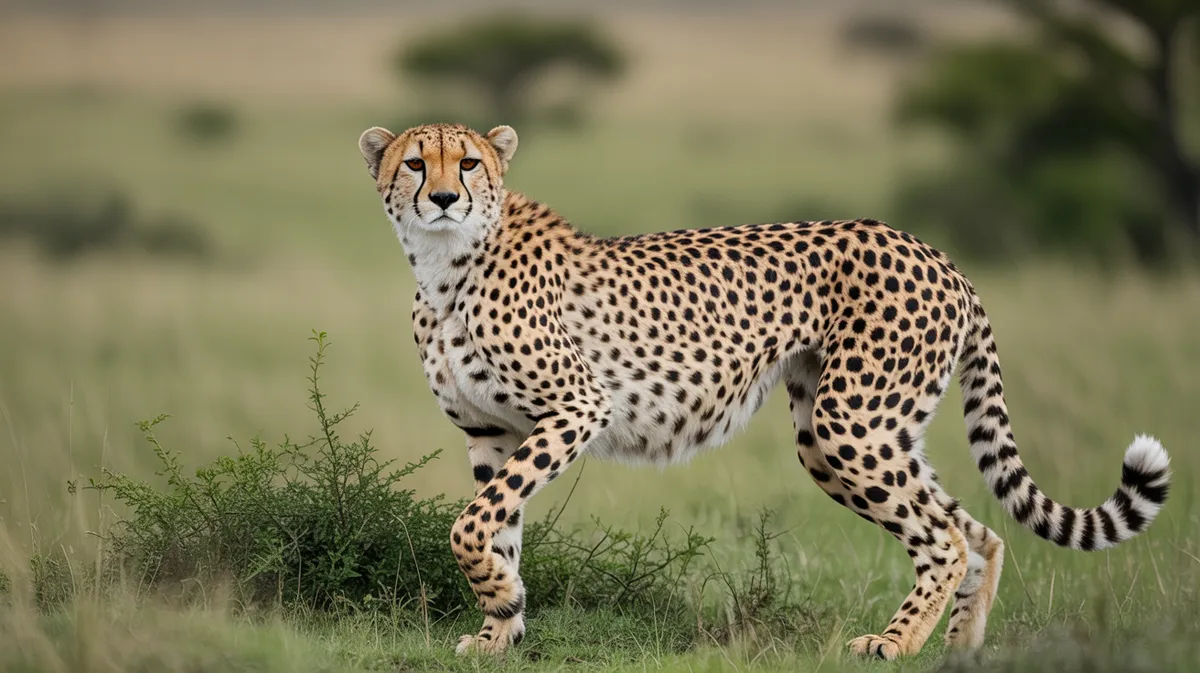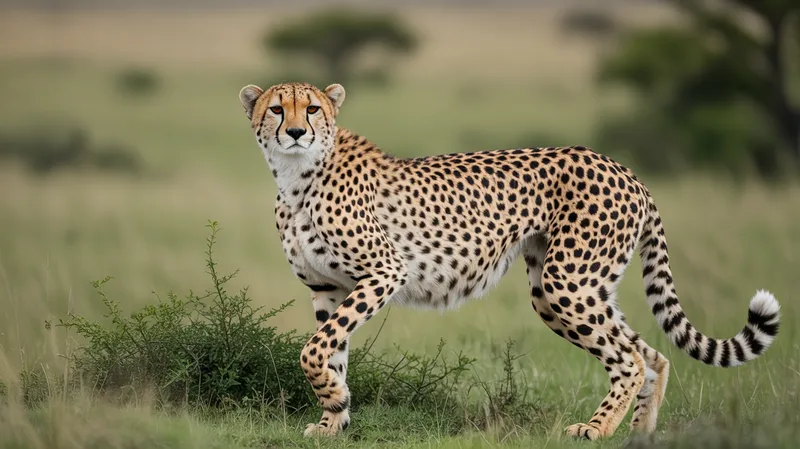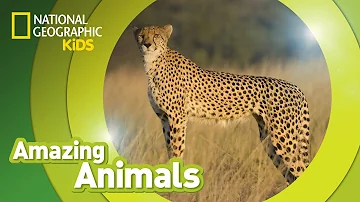
Cheetah
Acinonyx jubatus

Meet the Cheetah
The cheetah is the fastest land animal, renowned for its incredible acceleration and top speeds that can reach up to 120 km/h (75 mph) over short distances. It is a large felid with a slender, aerodynamic body, long legs, and distinctive black spots scattered across its golden-yellow coat. Cheetahs primarily inhabit open savannas and grasslands, where their keen eyesight helps them spot prey from a distance. Unlike other big cats, cheetahs rely on speed and agility rather than stealth or strength to hunt, using short, explosive sprints to capture antelopes and other small to medium-sized mammals.
Classification
Mammal
Habitat
Savanna and open grassland
Diet
Carnivore
Lifespan
10-12 years in the wild
Conservation
Vulnerable
Weight
21-72 kg
📖Fascinating Facts
Fastest Land Animal
Cheetahs can accelerate from 0 to 96 km/h (60 mph) in just a few seconds, making them the fastest land animals.
Exceptional Vision
Cheetahs have excellent eyesight and hunt mainly during the day, using their keen vision to spot prey from long distances.
Specialized Anatomy
Their lightweight build, long tail for balance, and enlarged nasal passages are all adaptations for high-speed pursuits.
📋Detailed Description
The cheetah (Acinonyx jubatus) is a medium to large-sized felid, uniquely adapted for high-speed pursuits. Its slender, lightweight frame, deep chest, and long limbs are complemented by a small, rounded head and distinctive black 'tear marks' running from the eyes to the mouth, which help reduce glare and enhance focus on prey. The cheetah's coat is short and coarse, colored tawny to pale buff with 2,000–3,000 solid black spots, providing camouflage in grassland habitats. Unlike other big cats, cheetahs have non-retractable claws that function much like running spikes, offering superior grip during sprints. The flexible spine acts as a spring, allowing for an extended stride length of up to 7 meters at full speed. The tail is muscular and flattened, serving as a dynamic rudder for balance and rapid directional changes. Cheetahs possess large nasal passages and lungs relative to body size, facilitating rapid oxygen intake during chases. Their vision is acute, adapted for spotting prey at distances up to 5 km. Adult cheetahs typically measure 1.1–1.5 meters in body length, stand 67–94 cm at the shoulder, and weigh between 21 and 65 kg, with males slightly larger than females. Cheetahs are diurnal, relying on daylight for hunting and communication, and are generally solitary or form small social groups known as coalitions.
💡 Did you know?
Despite their speed, cheetahs lose up to 50% of their kills to larger predators such as lions, leopards, and hyenas.
🔬Research & Sources
Wikipedia Summary
The cheetah is a large cat and the fastest land animal. It has a tawny to creamy white or pale buff fur that is marked with evenly spaced, solid black spots. The head is small and rounded, with a short snout and black tear-like facial streaks. It reaches 67–94 cm (26–37 in) at the shoulder, and the head-and-body length is between 1.1 and 1.5 m. Adults weigh between 21 and 65 kg. The cheetah is capable of running at 93 to 104 km/h ; it has evolved specialized adaptations for speed, including a light build, long thin legs and a long tail.
Last Modified: 6/4/2025
🎭Behavior & Social Structure
Cheetahs are primarily diurnal, with peak activity during early morning and late afternoon to avoid the heat of midday. They are solitary hunters, though males—often siblings—may form stable coalitions that cooperate in territory defense and hunting. Females are more solitary, except when raising cubs. Cheetahs hunt by stalking prey (typically small to medium-sized ungulates such as Thomson's gazelle, impala, and springbok) to within 60–100 meters before launching a high-speed chase. Hunts are brief, usually lasting less than a minute, as cheetahs can only sustain maximum speed for 20–30 seconds before overheating. After a successful kill, cheetahs eat quickly to avoid kleptoparasitism by lions, hyenas, or leopards. Vocalizations include chirps (used to locate cubs or coalition partners), growls, hisses, and purrs. Scent marking and visual cues are important for territory maintenance and communication.
👶Reproduction & Life Cycle
Cheetahs are polygynous, with no fixed breeding season, though births often peak during the wet season when prey is abundant. Females reach sexual maturity at 20–24 months, while males mature slightly later. Courtship involves scent marking and vocalizations, with males sometimes competing for access to estrous females. After mating, gestation lasts approximately 90–95 days. Litters typically consist of 3–5 cubs (range 1–8), born in secluded dens. Cubs are born blind and helpless, with a mantle of long, silvery fur along the back, believed to provide camouflage and mimic the appearance of honey badgers (a potential predator deterrent). Maternal care is intensive; the mother moves cubs frequently to avoid predators. Cubs are weaned at 3–6 months but may remain with the mother up to 18 months, learning hunting skills. Juvenile mortality is high, with up to 90% lost to predation in some regions.
🛡️Adaptations & Survival
Cheetahs exhibit a suite of morphological and physiological adaptations for speed: a highly flexible spine for extended stride, long limbs, lightweight skeleton, and specialized muscles for rapid acceleration. Their enlarged adrenal glands and heart support intense bursts of activity. Non-retractable claws and tough foot pads provide traction, while the long tail aids in balance and steering. Nasal passages, lungs, and adrenal glands are proportionally large to maximize oxygen uptake and stress response. The black facial 'tear marks' reduce sun glare and enhance focus on prey. Behaviorally, cheetahs time hunts for cooler periods and use tall grass or terrain for stalking. Cubs' mantle fur provides camouflage and predator mimicry.
🎨Cultural Significance
Cheetahs have held symbolic importance across cultures for millennia. Revered in Ancient Egypt, they were depicted in art and kept as royal hunting companions. In Persian and Indian courts, cheetahs were trained for coursing game, a practice that contributed to their decline in Asia. The cheetah symbolizes speed, grace, and agility in African folklore and modern iconography. Its image is used in conservation campaigns, sports branding, and as a national symbol (e.g., Namibia). Traditional uses have included pelts and live animals for status, though such practices are now illegal or discouraged.
🔬Recent Research & Discoveries
Recent research has focused on cheetah genetics, revealing extremely low genetic diversity due to historical population bottlenecks, which has implications for disease susceptibility and reproductive health. GPS collar studies have provided insights into home range sizes (ranging from 50 to over 1,000 km²), movement ecology, and the impacts of habitat fragmentation. Conservation genetics and assisted reproduction (e.g., artificial insemination) are being explored to bolster captive and wild populations. Studies on cheetah stress physiology have highlighted the species' sensitivity to environmental change and captivity. Ongoing research also examines human-cheetah conflict mitigation, prey dynamics, and the effectiveness of protected corridors in maintaining viable populations.
🎥Wildlife Videos

CHEETAHS | Lords of Speed and Shadows | Animal documentary
Welcome to "CHEETAHS: Lords of Speed and Shadows," an exhilarating journey into the lives of nature's fastest land predators.
WILD NATURE - Nature animal documentary

Wildlife Instincts | Cheetah - The Fastest Animal on Earth | Free Documentary Nature
Wildlife Instincts: Cheetah - The Fastest Animal on Earth | Wildlife Documentary Watch 'Wildlife Instincts: Pallas's Cat - Master of ...
Free Documentary - Nature

Cheetah – The Price of Speed | Free Documentary Nature
Cheetah - The Price of Speed | Wildlife Documentary Watch 'Birds of Passage - A Secret Journey Through the Skies' here: ...
Free Documentary - Nature

Cheetahs 101 | Nat Geo Wild
About National Geographic Wild: National Geographic Wild is a place for all things animals and for animal-lovers alike. Take a ...
Nat Geo Animals

Wildlife | Episode 1: Tiger, Lion, Leopard & Jaguar - The Four Big Cats | Free Documentary Nature
Wildlife: Episode 1 - Tiger, Lion, Leopard & Jaguar - The Four Big Cats | Wildlife Documentary Watch 'Wildlife - Episode 2: ...
Free Documentary - Nature

Cheetah | Amazing Animals
About Amazing Animals: Amazing Animals is a series that profiles a different animal in each episode. These short, one-minute ...
Nat Geo Kids
🌍Habitat Information
The Cheetah typically inhabits Savanna and open grassland environments. Cheetahs have adapted to their environments with specialized features and behaviors.
Primary Habitat:
Savanna and open grassland
More detailed habitat information will be available soon.
🛡️Conservation Status
The Cheetah is currently classified as Vulnerable. Conservation efforts are crucial for preserving this species for future generations.
Common Threats:
- 🏠Habitat loss and fragmentation
- 🌡️Climate change impacts
- 🎯Hunting and poaching
- 🏭Human-wildlife conflict
⚠️Threats & Conservation Challenges
Cheetah populations face numerous threats: habitat loss and fragmentation due to agriculture and human settlement, depletion of prey base, direct persecution (retaliatory killings, poaching), and high cub mortality from predation. Genetic bottlenecks have resulted in low genetic diversity, increasing susceptibility to disease and reducing reproductive success. Human-wildlife conflict, illegal pet trade, and road mortality are significant challenges. Current global estimates suggest fewer than 7,100 adult and adolescent cheetahs remain in the wild, with populations declining and highly fragmented. The species is classified as Vulnerable by the IUCN, with some subspecies (e.g., A. j. venaticus, the Asiatic cheetah) Critically Endangered.
🔬Scientific Classification
Scientific Name
Acinonyx jubatus
Classification Hierarchy
🔍 About Taxonomic Classification
Taxonomic classification is a hierarchical system used by scientists to classify and organize living organisms based on shared characteristics and evolutionary relationships.
The system moves from broad categories (Kingdom) to increasingly specific ones, with each animal's scientific name typically consisting of its Genus and species.
📝Community Notes
Share your observations and insights about the Cheetah with our community of wildlife enthusiasts.
Join Our Community
Sign in to share your observations and connect with fellow wildlife enthusiasts.
Sign In to ContributeNo community notes yet
Be the first to share your observations about the Cheetah!
Explore Cheetah
Select a tab above to learn more about this amazing animal.
📸Photo Gallery
No photos available for this animal yet.
🌟Discover More Wildlife
Continue your journey of discovery with more fascinating animals from our database
